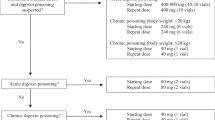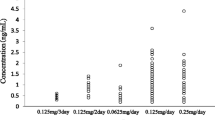Summary
17 patients with severe digoxin intoxication were successfully treated with 320 to 480 mg Fab fragments of digoxin-specific IgG from sheep. The infusion period ranged between 0.5 and 7 h. Serum and urine concentrations of digoxin bound to Fab fragments, and in 11 cases unbound Fab fragments in serum, were determined during and after the infusion.
The renal clearance of bound digoxin and therefore of the antibody was 13.6 ml/min. The median extrarenal clearance of the Fab fragments was 10.9 ml/min.
The half-life of the serum concentrations starting at 12 h was 14.3 h, and the value was increased to 25.4 h when regression began at 24 h; the corresponding apparent distribution volumes were 25.9 and 541. These figures exceed the volume of the extracellular space and suggest intracellular penetration of the Fab fragments.
The dosage of the antibody should be sufficiently high to bind digoxin in the most severe cases of poisoning. The maximum serum concentrations of bound antibody were 30 mg/l after 3 h and 20 mg/l after 5 h. A loading dose of 160 mg followed by an infusion of 0.5 mg/min was sufficient to absorb digoxin re-diffusing into the serum during the first 8 h. In some cases free digoxin reappeared in the serum 8–12 h after beginning the treatment. This might be prevented by infusing a further ampoule at a rate of 0.1 mg/min or less.
Similar content being viewed by others
References
Betzien G, Dietmann K, Schaumann W (1980) Resorption, renale und extrarenale Clearance von Digoxin. Herz/Kreisl. 12, 115–120
Cockcroft DW, Gault HM (1976) Prediction of creatinine clearance from serum creatinine. Nephron 16: 31–41
Grabensee B, Peters U (1983) Therapie schwerer Digitalisvergiftungen mit spezifischen Antikörpern. Herz/Kreisl 15: 501–502
Harenberg J, Staiger Ch, Wahl P, Smolarz A (1983) Therapie einer schweren Digitalis-lanata-Intoxikation mit Schaf-Antidigoxin-Fab. Therapiewoche 33: 6446–6452
Hess T, Scholtysik G, Riesen W (1978) The prevention and reversal of digoxin intoxication with specific antibodies. Am Heart J 96: 486–495
Hess T, Stucki P, Barandun S, Scholtysik G, Riesen W (1979) Treatment of a case of Lanatoside C intoxication with digoxin-specific F(ab')2 antibody fragments. Am Heart J 98: 767–771
Hess T, Stucki P, Barandun S, Scholtysik G, Riesen W (1979) Antikörperbehandlung einer Digoxin-Intoxikation bei einem Patienten mit Niereninsuffizienz. Dtsch Med Wochenschr 104: 1273
Jax W, Gevelmann M, Neubert P, Smolarz A (1983) Behandlung einer schweren Glykosidintoxikation mit Schaf-Antidigoxin-Fab. Z Intensivmed 20: 250–254
Kaul S, Pfeifer GP, Drahovsky D (1984) Preparation of monoclonal antibodies against DNA-cytosine-5-methyltransferase from human placenta. Eur J Cell Biol 34: 330–335
Murphy DJ, Bremner WF, Haber E, Butler VP, Smith TW, Gaum WE (1982) Massive digoxin poisoning treated with Fab fragments of digoxin-specific antibodies. Pediatrics 70: 472–473
Smith TW, Butler VP, Haber E, Fozzard H, Marcus FI, Bremner WF, Schulman IC, Philipps A (1982) Treatment of life-threatening digitalis intoxication with digoxin-specific Fab antibody fragments. N Engl J Med 307: 1357–1362
Smith TW, Haber E, Yeatman L, Butler VP (1976) Reversal of advanced digoxin intoxication with Fab-fragments of digoxin-specific antibodies. N Engl J Med 294: 797–800
Smolarz A, Abshagen U (1986) Digitalis-Antikörper-Fragmente (Fab) bei 90 schweren Glykosidvergiftungen. Klinische Erfahrungen aus einer multizentrischen Studie. Herz/Kreisl 18: 261–266
Smolarz A, Roesch E, Lenz H, Neubert P, Abshagen U (1984) Erfahrungsbericht über die Behandlung von 16 schweren Glykosidvergiftungen mit Digitalis-Antikörper-Fragmenten (Fab). Z Kardiol 73: 113–119
Smolarz A, Roesch E, Lenz H, Neubert P, Abshagen U (1985) Digoxin specific antibody fragments (Fab) in 34 cases of severe digitalis intoxication. Clin Toxicol 23: 327–340
Wahl G, Buecking J, Huebner H, Schwartau M (1983) Behandlung einer lebensbedrohlichen Digoxin-Intoxikation mit heterologen digoxinspezifischen Antikörperfragmenten. Dtsch Med Wochenschr 108: 1441–1443
Weller P, Peters U, Dickmanns HA, Hespe TH, Adam M, Allolio B, Smolarz A, Grabensee B (1983) Antidigoxin-Fab-Fragmente bei suizidaler Digoxin-Intoxikation. Dtsch Med Wochenschr 108: 1437–1440
Wenger TL, Butler VP, Haber E, Smith TW (1985) Treatment of 63 severely digitalis-toxic patients with digoxin-specific antibody fragments. J Am Coll Cardiol 5: 118A-123A
Zilker T, v. Clarmann M, Felgenhauer N, Bihlmayr J, Smolarz A (1983) Durchbruch in der Therapie der lebensbedrohlichen Digitalisintoxikation durch Einsatz von Schaf-Antidigoxin-Fab-Fragmenten. Intensivbehandlung 8: 149–157
Zucker AR, Lacina SJ, DasGupta DS, Fozzard HA, Mehlman D, Butler VP, Haber E, Smith TW (1982) Fab fragment of digoxin-specific antibodies used to reverse ventricular fibrillation induced by digoxin ingestion in a child. Pediatrics 70: 468–471
Author information
Authors and Affiliations
Rights and permissions
About this article
Cite this article
Schaumann, W., Kaufmann, B., Neubert, P. et al. Kinetics of the fab fragments of digoxin antibodies and of bound digoxin in patients with severe digoxin intoxication. Eur J Clin Pharmacol 30, 527–533 (1986). https://doi.org/10.1007/BF00542410
Received:
Accepted:
Issue Date:
DOI: https://doi.org/10.1007/BF00542410




